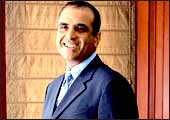 |
| From the Front: Ratan Tata,
who became Chairman of Tata Teleservices in October 2005,
is doing everything he can to get his and his company's point
of view on spectrum across |
Ratan
Tata is angry. The chairman of Tata group has been busy interacting
with people such as the Chief Minister of West Bengal (about the
location of a plant for the group's Rs-1,00,000 car), chairing
board meetings and doing other things that someone who heads a
Rs 80,000-crore group would be expected to do (so much so that
he couldn't meet with Business Today for this article). He is
also, presumably, upset that the government is veering around
to the point of view that incremental spectrum allocation-spectrum
is essentially a frequency wavelength that mobile telephony operators
need; it is what is termed a public goods and needs to be allocated
by the government in return for a consideration; more on this
in The Ins And Outs Of Spectrum-should be done on the basis of
the subscriber base of the companies and the technology it uses.
That would mean that a telco's chances of getting spectrum are
directly related to the number of subscribers it has on its rolls.
Tata has never been in favour of this argument. In May 2005, he
suggested, for the first time, that companies pay for spectrum,
say Rs 1,500 crore for providing services across the country.
Over the past few months, he is believed to have written about
three letters to the government putting across his point of view.
There is merit to Tata's arguments, although
adopting it could mean revisiting, at least in part, the New Telecom
Policy of 1999 (NTP 99), which replaced a licence-fee regime with
a revenue sharing one and kick-started India's mobile telephony
revolution. It could also mean reviewing the unified licensing
regime that came into effect in 2004, and effectively allowed
companies that originally had licences to provide fixed telephony
services to offer mobile telephony ones under pretty much the
same terms as cellular companies did.
The services of the fixed telephony companies
were built on the CDMA (Code Division Multiple Access) technology,
a spectrally-efficient wireless technology that is popular in
some parts of the world while those of the cellular companies
were based on GSM (the popular standard for wireless telephony
as evident from the fact that the name has outgrown its acronym
and become a noun), but the issue was never about technology,
although the competing lobbies initially made it out to be that
way.
| THE TATAS IN TELECOM |
|
WHAT WENT WRONG
» Late
starters in the wireless business. Got into the business
on a full-fledged basis only after the unified licensing
regime
» Not
perceived to be very aggressive in a market dominated by
aggressive players like Bharti, Hutch, BSNL and Reliance
» VSNL
was disinvested in early 2002. The Tatas had to face a situation
of losing their monopoly in the international telephony
business
» Both
BSNL and MTNL were looking to start international telephony
services on their own, which meant VSNL had to look for
other business avenues
NOW WHAT?
» Tata
Teleservices has announced aggressive promotional schemes
like the recent one of incoming calls free for two years
» The
group is looking to offer all the services under the Tata
Indicom brand name, which means it can get across to more
customers
» Going
overseas is a clear strategy-TGN and Teleglobe are cases
in point
» Broadband
will be the big story in addition to enterprise solutions
|
The real issue was access to India's booming
mobile telephony market. It was about companies that had initially
missed out on bagging licences to offer mobile telephony services
going out and doing just that (offering mobile telephony services).
When the government started giving out spectrum
to the CDMA companies, it offered them less, citing the technology's
spectral efficiency. That should put the CDMA lobby soundly behind
Tata. If it doesn't, it is because the country's largest CDMA
telco, Reliance Infocomm, has a little over 19 million subscribers
(at the end of April 2006, making it the country's second largest
mobile telephony player after Bharti Tele-Ventures), and isn't
averse to a subscriber-based allocation of spectrum.
Tata's Tata Teleservices Limited (TTSL),
which jumped into the mobile bandwagon only after the unified
licensing regime came into play, in 2004, well after Reliance
did (in late 2002), boasts around 9.5 million subscribers, and
a subscriber-based spectrum policy could hamper the company's
growth.
That could, at one level, put paid to Tata's
ambitions of making his group a heavy-hitter in the booming telecom
space: Both TTSL and VSNL (Videsh Sanchar Nigam Ltd), a long distance
telephony player the group acquired from the government in 2002,
are on the comeback trail (numbers would suggest that they have
come back), and the last thing they'd like is a policy regime
that isn't conducive to them.
Late-starter To Aggressive Player
In the four months between January 1 and
April 30 this year, TTSL added 1.26 million subscribers. Industry
leader Bharti did 4.35 million, and Reliance, 2.47 million. Despite
boasting a subscriber base of over 102 million (April 30), India's
mobile telephony story is far from over. "The game in other
markets is over as far as new entrants are concerned," says
Darryl Green, CEO, TTSL, adding that there is nothing that matches
the excitement of being in this market in India. "The number
of players means fierce competition."
 |
DARRYL GREEN
CEO/ Tata
Teleservices Ltd
"If you want to be among the top three players in the
market (and TTSL does) you must have a market share of at
least 20 per cent" |
In many ways Green's presence in TTSL is itself
indication of the company's seriousness. The American was hired
from Vodafone KK, Japan, where he was President & CEO and
has overseen the company's efforts to break into the big league
in the Indian telephony space. However, despite its best efforts-the
recent non-stop-mobile offer from the company, for instance, where
it offered free incoming for two years without a need to recharge-legacy
factors ensure that it trails the other large companies, although
Green is convinced that this isn't such a big issue as it is being
made out to be.
Nor is making money in a context where tariffs
are on a down slope. "An incremental minute (of usage) can
add as much as 80 per cent to your gross margins," explains
Green. Indeed, in 2005-06, TTSL's revenues in the last quarter
(January to March 2006) are rumoured to be twice its revenues
in the first (April to June 2005). Much of that has come from
aggressive growth-oriented strategies, including lower tariffs,
promotions and alliances with Chinese handset manufacturers such
as ZTE and Huawei to reduce the cost of going mobile. By 2011
(five years from now), claims Green, TTSL will have 100 million
subscribers on its rolls. India's telecom ministry expects the
country to have 500 million mobile connections by 2010 (by 2011,
going by these numbers, it should have around 570). TTSL's share
works out to around 17 per cent. "If you want to be among
the top three players in the market (and TTSL does) you must have
a market share of at least 20 per cent," says Green.
India's low average revenue per user (ARPU)
of Rs 400 per month (TTSL claims its own is Rs 500 per month)
could be a cause for concern (volumes could come at the cost of
profit margins), but that doesn't worry Ravi Menon, Managing Director
and Co-Head (Investment Banking), HSBC Securities and Capital
Markets. "Yes, India does have a low ARPU, but since capex
costs have fallen, EBIDTA (earnings before interest, depreciation,
taxes and amortisation) margins will be healthy." Menon's
opinion on India and Green's on his company is shared by private
equity firm Temasek (it is the investment arm of the Singapore
government) that recently acquired a 9.9 per cent stake in TTSL
for an estimated $350 million (Rs 1,575 crore).
 |
N. SRINATH
Executive Director/ Videsh Sanchar Nigam Ltd
"After the TGN buy, we could compete
on a global basis. In five years, we will look more like an
IT company rather than a telecom one" |
An All-new Global Player
The Tata Group has also managed to turn around
VSNL, an international long-distance (ILD) company it acquired
from the government in 2002. Soon after, the company's monopoly
on the business ended (as it was expected to), the Tata Group
delayed entering the national long distance (NLD) telephony business
(licences for which had been given to VSNL free in return for
the premature termination of the monopoly on ILD telephony), and
with TTSL being a slow starter, the company saw its numbers falling.
Bharti and Reliance, for instance, had vibrant local operations
(as well as NLD and ILD licences) and they leveraged this to good
effect pushing their own traffic onto the international network.
The economics of interconnect also meant that a telco that had
a presence in all three made more money from every international
call than one that was merely present in the international telephony
space.
All along, however, says N. Srinath, Executive
Director, VSNL, the company was working to move from being a "wholesale
monopoly" to a "multi-business competitive company".
"Getting into national long distance telephony was an immediate
and logical extension," he adds, but with voice tariffs across
local, national and international telephony on the decline, the
company wanted to look at the real sweet spots in the market.
These were enterprise business, and a global-scale operation in
international telephony. The company managed to do the second
by adopting the acquisition route (see VSNL's Key Acquisitions).
The 2004 acquisition of TGN (Tyco Global Network) helped VSNL
complement its own international network (TGN connected Tokyo
to the us West Coast, and then to Europe, and Tokyo to Singapore).
"Our services before the TGN acquisition were India-centric,"
says Srinath. "Now, we could compete on a global basis."
And the $239-million (Rs 1,076-crore) acquisition
of Teleglobe helped VSNL address the other problem it faced. "We
were not getting enough (international) traffic from the others
and were dependant on players such as TTSL and others, who did
not have a licence," says Srinath. Teleglobe, however, was
a big player in the traffic-to-and-from-India market.
 |
KISHOR CHAUKAR
Managing Director/Tata Industries
"The future will see us increasing our footprint, ramping
up the subscriber base and offering more value-added services
globally" |
Thanks to the acquisition, of the 12 billion
minutes that the Indian international telephony market will be
worth in 2006-07, VSNL (with Teleglobe under its belt) will account
for 4.8 billion (40 per cent). VSNL's acquisitions, a Mumbai-based
equity analyst points out, have also helped it control costs and
increase profit margins. And they have also come cheap. "An
acquisition like TGN at a cost of $130 million (Rs 585 crore)
is small considering the potential in the business," he adds.
VSNL has also made an entry into Africa,
considered the next big market for telcos after Asia by almost
anyone in the business, by acquiring a 26 per cent stake in South
Africa's Second Network Operator (SNO), a provider of services
that include fixed telephony services, data, internet and broadband.
In five years (though the first service will be launched in July
this year), says Srinath, "SNO will be up and running and
that will contribute a big chunk of our revenues". However,
he expects the company's US and European operations to be bigger.
"In five years, I think we will look more like an it company
rather than a telecom company." Enam Financial Consultants'
Vice President Salil Pitale believes that some of India's larger
telcos are well placed to harness the power of the broadband infrastructure
to offer high-end value-added services (virtual private networks
or VPNS, data centre hosting, business continuity planning and
the like) to their consumers.
That move towards data is crucial; voice
is rapidly becoming a commodity even in the international telephony
business, one reason why, despite its acquisitions, VSNL's numbers
do not come close to its 2001-02 high. And as this magazine goes
to press, international bandwidth major flag Telecom, now owned
by Reliance Communication Ventures, has gained access to one-time
partner VSNL's landing station in Mumbai. This comes after the
International Court of Arbitration allowed flag to sell bandwidth
directly to end users in India. More significantly, flag could
also be compensated for VSNL's earlier decisions to prevent it
access to landing stations. In short, this will free a huge quantity
of bandwidth and will also lead to a fall in bandwidth prices.
THE INS AND OUTS OF SPECTRUM
An explanation of what the fuss
is all about. |
 |
 |
| A reason to smile: Bharti's
Sunil Mittal (left) and Reliance's Anil Ambani are happy
with the proposed spectrum policy |
Where do things stand now?
An empowered Group of Ministers, headed by Defence Minister
Pranab Mukherjee, is looking at the DoT (Department of Telecom)
policy on spectrum allocation.
Who's fighting the battle?
Ratan Tata, for one, who has shot off letters to DoT,
the Communications Minister and the Prime Minister on the
need for a more comprehensive approach to the allocation
of spectrum. And the Cellular Operators Association of India,
whose constituents, all GSM telcos, stand to benefit from
the policy, has come out in favour of it.
What does DoT's policy say?
That GSM operators will get a maximum allocation of 15
Mhz per circle and CDMA ones, 7.5 Mhz. Today, GSM operators
do a maximum of 8 Mhz (although more has been given to some
companies on a case-by-case basis; Bharti has close to 10
Mhz in Delhi), and CDMA, 5 Mhz.
Why has subscriber base become a contentious issue?
Simple, because DoT has retained its existing policy prescribing
a specific number of subscribers that the operators have
to achieve before they can be eligible for fresh frequency
(spectrum). According to this, Bharti is now eligible for
15 Mhz in Delhi where it has over 2 million users. Reliance,
however, will get 7.5 Mhz only when it reaches the 2 million
mark in the city. DoT has specified the numbers at which
operators will be eligible for extra spectrum for each circle
and for GSM and CDMA players.
Who gains, who loses?
Large mobile telephony firms that use GSM (such as Bharti
and Hutch) win. So does Reliance, a CDMA firm that has a
huge number of subscribers. Tata Teleservices, with less
than 10 million subscribers, is a clear loser.
|
Getting It All Together
Tata has always wanted to see all the group's
it companies under one umbrella (which has now happened with TCS),
and all the telecom companies under another. The second would
involve the Tata Group buying out the government's residual 26
per cent stake in VSNL and then merging TTSL with it.
That fits in very well with the vision Kishor
Chaukar, MD, Tata Industries (one of the men behind the group's
telecom foray), has for the future of telecom services of the
kind TTSL offers and it services of the kind VSNL does. "Convergence
is what it will be about," he says. "Companies, for
instance, would like a single window relationship that will cover
it and telecom-related services."
That (the merger), though, is in the realm
of speculation according to Chaukar. VSNL has risen from the ashes
to become a strong international bandwidth and value-added services
player, and TTSL is today the country's fifth largest mobile telephony
company (in terms of subscribers). "The future will see us
increasing our footprint, ramping up the subscriber base and offering
more value-added services," says Chaukar.
For the first time since it entered the business,
the Tata Group looks like a serious contender in the telecommunications
space. It would be a pity should that change and TTSL suffer a
setback because of the spectrum issue. Which could explain why
Tata himself is keen that this doesn't happen: the stakes are
so much higher now.
|









